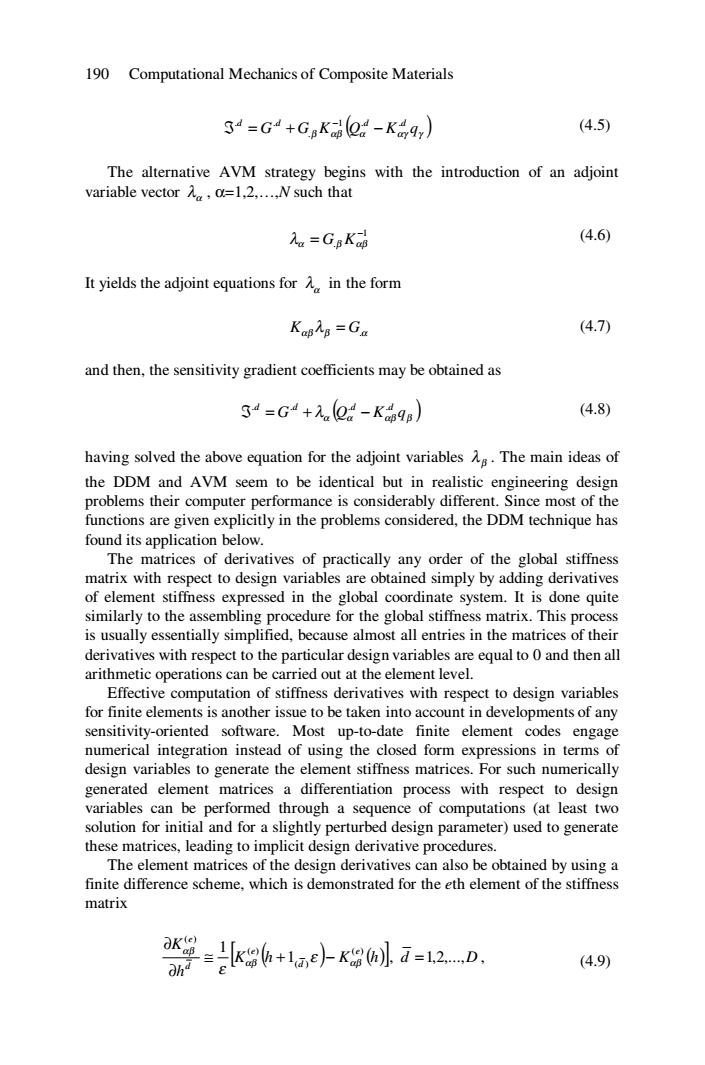正在加载图片...

190 Computational Mechanics of Composite Materials 34=G4+G8KaQ-Kaqy) (4.5) The alternative AVM strategy begins with the introduction of an adjoint variable vector =1,2,...,N such that Aa =G.pKap (4.6) It yields the adjoint equations forA in the form KaplB =Ga (4.7) and then,the sensitivity gradient coefficients may be obtained as 34=G4+.0a-K9B】 (4.8) having solved the above equation for the adjoint variables A.The main ideas of the DDM and AVM seem to be identical but in realistic engineering design problems their computer performance is considerably different.Since most of the functions are given explicitly in the problems considered,the DDM technique has found its application below. The matrices of derivatives of practically any order of the global stiffness matrix with respect to design variables are obtained simply by adding derivatives of element stiffness expressed in the global coordinate system.It is done quite similarly to the assembling procedure for the global stiffness matrix.This process is usually essentially simplified,because almost all entries in the matrices of their derivatives with respect to the particular design variables are equal to 0 and then all arithmetic operations can be carried out at the element level. Effective computation of stiffness derivatives with respect to design variables for finite elements is another issue to be taken into account in developments of any sensitivity-oriented software.Most up-to-date finite element codes engage numerical integration instead of using the closed form expressions in terms of design variables to generate the element stiffness matrices.For such numerically generated element matrices a differentiation process with respect to design variables can be performed through a sequence of computations (at least two solution for initial and for a slightly perturbed design parameter)used to generate these matrices,leading to implicit design derivative procedures. The element matrices of the design derivatives can also be obtained by using a finite difference scheme,which is demonstrated for the eth element of the stiffness matrix 器k6+l小=2。 (4.9)190 Computational Mechanics of Composite Materials ( ) G GβKαβ Qα Kαγ qγ d d 1 .d .d . . . ℑ = + − − (4.5) The alternative AVM strategy begins with the introduction of an adjoint variable vector λα , α=1,2,…,N such that 1 . − λα = GβKαβ (4.6) It yields the adjoint equations for λα in the form Kαβλβ = G.α (4.7) and then, the sensitivity gradient coefficients may be obtained as ( ) G λα Qα Kαβqβ .d .d .d .d ℑ = + − (4.8) having solved the above equation for the adjoint variables λβ . The main ideas of the DDM and AVM seem to be identical but in realistic engineering design problems their computer performance is considerably different. Since most of the functions are given explicitly in the problems considered, the DDM technique has found its application below. The matrices of derivatives of practically any order of the global stiffness matrix with respect to design variables are obtained simply by adding derivatives of element stiffness expressed in the global coordinate system. It is done quite similarly to the assembling procedure for the global stiffness matrix. This process is usually essentially simplified, because almost all entries in the matrices of their derivatives with respect to the particular design variables are equal to 0 and then all arithmetic operations can be carried out at the element level. Effective computation of stiffness derivatives with respect to design variables for finite elements is another issue to be taken into account in developments of any sensitivity-oriented software. Most up-to-date finite element codes engage numerical integration instead of using the closed form expressions in terms of design variables to generate the element stiffness matrices. For such numerically generated element matrices a differentiation process with respect to design variables can be performed through a sequence of computations (at least two solution for initial and for a slightly perturbed design parameter) used to generate these matrices, leading to implicit design derivative procedures. The element matrices of the design derivatives can also be obtained by using a finite difference scheme, which is demonstrated for the eth element of the stiffness matrix [ ] K ( ) h K ( ) h h K e d e d e ( ) ( ) ( ) ( ) 1 1 αβ αβ αβ ε ε ≅ + − ∂ ∂ , d =1,2,...,D , (4.9)